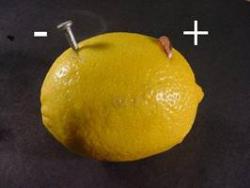DID
By alien_0731
@alien_0731 (1237)
India
November 18, 2006 7:36am CST
Creating a battery from a lemon is a common project in many science text books. Successfully creating one of these devices is not easy.
Batteries consist of two different metals suspended in an acidic solution. Copper and Zinc work well as the metals and the citric acid content of a lemon will provide the acidic solution.
Batteries like this will not be able to run a motor or energize most light bulbs. It is possible to produce a dim glow from an LED.
The picture at the top of this page shows a basic lemon battery, a lemon, copper penny and zinc coated nail.
The lemon: A large, fresh, "juicy" lemon works best.
This is a single cell of a battery. The zinc nail and the copper penny are called electrodes. The lemon juice is called electrolyte.
All batteries have a " +" and "-" terminal. Electric current is a flow of atomic particles called electrons. Certain materials, called conductors, allow electrons to flow through them. Most metals (copper, iron) are good conductors of electricity. Electrons will flow from the "-" electrode of a battery, through a conductor, towards the "+" electrode of a battery. Volts (voltage) is a measure of the force moving the electrons. (High voltage is dangerous!)
1 person likes this
3 responses
@krisantapapa (820)
• Philippines
21 Nov 06
Thanks for sharing the knowledge, i never knew this thing until you discussed it here in mylot. Free knowledge, take it from alien.
@kastmandap (117)
• India
18 Nov 06
I too have a next idea .. that i have practically done.. U just crush patotes to small piecses in a plastic jug... The more small pieces the effective it is...then u just deep a carbon rod n zinc plate at different places inside the jug.. the zinc plate will act as a -ve terminal n the carbon rod will act as positive terminal... If u connect it to a table clock.. To ur surprise u will see that it really works...








